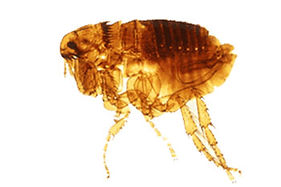

CALL: 07934112078
Pest Control Services

A. D. A
'EAGLE EYED ATTENTION TO DETAIL'
& Environmental

Fleas
Adults feed on the blood of dogs and cats and they occasionally bite humans. The whole life cycle is spent in the vicinity of the host, but only the adult fleas are blood-sucking parasites and even these leave their host from time to time. Fleas can go without food for several months but the females need a blood meal before they can produce eggs.
The eggs are ovoid, whitish in colour and deposited loose on the host animal or in its haunts and sleeping-places. Flea larvae live on organic detritus, including the blood-droppings of adult fleas, in and around the lair or home of the host. When fully grown, the larvae pupate in silken cocoons.
Adult fleas need a mechanical stimulus to initiate their emergence from the cocoon and this is generally in the form of vibrations caused by the movement of the host. This neat arrangement ensures that a host is nearby when the fleas emerge.
If no such stimulus is forthcoming, the fleas can remain dormant in their cocoons for many months. The whole life cycle from egg to adult takes 2-3 weeks in favourable temperatures, but may take much longer in cool conditions. The Dog Flea is a vector of the Dog Tapeworm, Dipylidium caninum, which can also affect man.


Cat Flea (Ctenocephalides felis)
Dog Flea (Ctenocephalides canis)
Fleas are external parasites, living by hematophagy off the blood of mammals and birds. Found particularly in host bedding, many infestations in commercial and institutional premises derive from feral cats.
The body of a flea is flattened from side-to-side. Eyes and antennae inconspicuous, the latter lying in grooves on either side of the head. Mouthparts for piercing skin and blood-sucking. The hindlegs are relatively long for jumping.
There is a complex metamorphosis, with three larval stages, followed by a pupal stage enclosed in silken cocoon. Larvae elongate, slender and maggot-like, without eyes or legs. This is a fairly small Order containing about 1,800 known species.
Control Methods

Insecticidal Sprays / Powders
Monitoring Traps